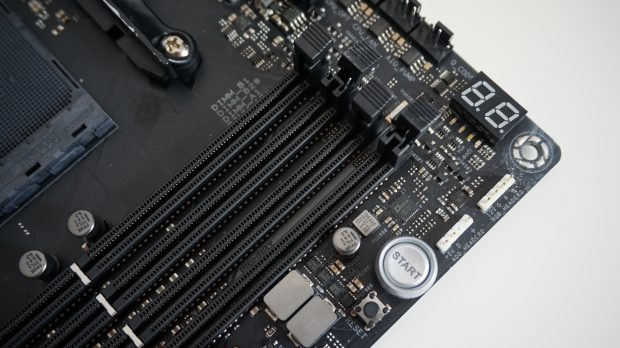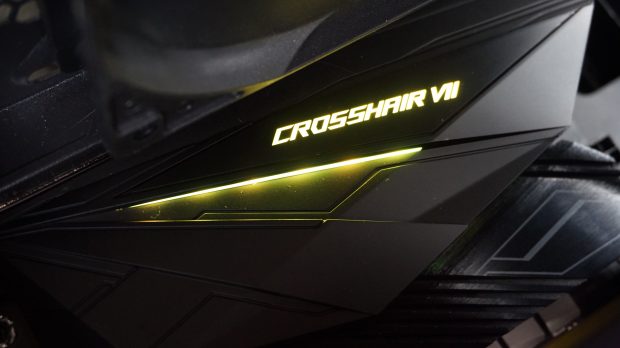The Asus ROG Crosshair VII Hero (Wi-Fi) – attempt saying that thrice quick – is sort of presumably the final word ATX motherboard for cooling and USB junkies – if you happen to’re batting for staff Ryzen+, that’s. If you thought having eight USB ports on the Asus ROG Strix X470F-Gaming and MSI X470 Gaming M7 AC was beneficiant, the Crosshair VII Hero provides 4 extra to the pile, coming in for a positively monstrous whole of 12. If all that wasn’t sufficient, you additionally get a whopping 9 fan headers for the best of cooled methods.
Nine fan headers I can nearly get behind, however I can’t even start to think about the type of state of affairs the place you’d have to have 12 USB ports. Still, when you can’t accuse Asus of being stingy in relation to peripheral assist, it does imply you’re giving up house for a number of show outputs (until you rely the only USB Type-C port), making it ill-suited to AMD’s different two new Ryzen chips, the Ryzen 3 2200G and Ryzen 5 2400G with built-in Vega graphics. As a companion for AMD’s Ryzen 7 2700 / 2700X or Ryzen 5 2600 / 2600X CPUs, then again, the Crosshair makes a mighty effective match. Let’s see if it’s value shopping for over the MSI X470 Gaming M7 AC.
But first a phrase on why you may wish to purchase an X470 motherboard within the first place. After all, when all 4 of AMD’s new Ryzen+ chips are already suitable (after a BIOS replace, in fact) with each pre-existing AM4 socket motherboard that’s at the moment obtainable – whether or not it’s bought a X370 chipset or one of many cheaper, much less fully-featured A320 and B350 chipsets – there’s truly little or no have to improve to or purchase a brand new X470 motherboard if you happen to’ve already bought one which works.

Yep, that’s two USB 2.zero ports (one in every of which will also be used to replace the BIOS with out coping with mentioned BIOS display screen or coming into the OS), eight USB 3.1 Gen 1 ports, one USB 3.1 Gen 2 port and one USB 3.1 Gen 2 Type-C port.
Well, going with an X470 board negates the necessity for a pesky BIOS replace for starters, as each board comes with Ryzen+ assist out of the field, however you additionally get AMD’s quite useful StoreMI acceleration tech for completely nadda. You’ll nonetheless need to obtain the software program from AMD’s website and configure it accordingly, however this primarily provides all SSD / HDD combos a brand new lease of life by turning each drives into one large SSD-like storage gadget, routinely transferring your most-used information to the SSD, whereas retaining your least visited folders on the HDD.
StoreMI adapts to the way you entry your information over time, too, so the stuff you want most at any given time ought to, in concept, take the least period of time to be retrieved. Naturally, this doesn’t make for a particularly reasonable testing surroundings, so I performed all my benchmarks with out StoreMI enabled.
Otherwise, you’re getting a really comparable set of options to the earlier tog canine chipset, the X370. In phrases of PCIe growth, the Crosshair VII Hero comes with two steel-reinforced PCIe x 16 3.zero slots that run at full-speed when used individually or x8 when used collectively (and even x8 / x4 while you’re additionally utilizing the highest M.2 slot), and a single PCIe x16 2.zero slot on the backside that runs at x4. All three can be utilized for an AMD CrossfireX setup, too, however Nvidia graphics card homeowners must make do with simply two-way SLI assist.
You additionally get 4 DIMM DDR4 slots that assist as much as 64GB of RAM and speeds of as much as 3466MHz when overclocked. That’s the identical as Asus’ X470F-Gaming, however slightly below the MSI M7 AC’s high velocity of 3600MHz. Or at the very least that’s based on the Crosshair VII Hero’s handbook, which is definitely totally different to Asus’ own website that claims an equal 3600MHz. Either method, your RAM will go very, very quick no matter which board you find yourself selecting.
As alluded to above, the Crosshair VII Hero comes with two M.2 slots for super-fast NVMe SSDs along with the usual six SATA ports you’ll discover on the far proper. Again, very similar to the Asus X470F-Gaming, solely one of many M.2 slots will get the advantage of an added heatsink to assist it run as cool and effectively as potential. Here, nonetheless, you’ll be able to transfer the heatsink to take a seat on high of whichever slot you want because of a second pair of mounting screws on the opposite slot. This nonetheless isn’t fairly as elegant because the MSI M7 AC’s double-pronged hinge resolution that cools each of its M.2 ports concurrently, but it surely does present slightly extra flexibility than its cheaper Asus cousin.
You additionally solely get two PCIe 2.zero x1 slots quite than the same old three, however with so many USB ports and built-in 802.11ac Wi-Fi at your disposal, it’s not like you’ll have to bolster the Crosshair VII Hero with plenty of further add-in playing cards anyway. Much extra helpful are these aforementioned 9 fan headers, together with one for a fan extension card (simply in case you want extra followers) and particular connectors for AIO water pumps and a excessive amperage fan.
It ought to come as no shock, then, to listen to the Crosshair VII Hero comes with a load of additional overclocking options as properly. While you don’t get a useful velocity increase knob just like the MSI M7 AC, you do get a numbered LED show for simple troubleshooting, assist for Asus’ ROG Probelt meter for detecting voltage and OC settings, plus power-on, reset and protected boot buttons, in addition to what Asus name a ReTry button to make use of through the booting course of the place the reset button fails to do something.
There’s additionally a slow-mode swap for excessive overclocking and liquid nitrogen (LN2) benching, which can be utilized to lower the processor frequency and stabilise your system so you’ll be able to higher hold observe of your overclocking knowledge when your PC will get unstable. It’s unlikely most individuals will ever want to make use of this, however if you happen to’re the type that will get sizzling below the collar on the point out of 9 fan headers, then this will very properly be the factor for you.
Rounding out the Crosshair VII Hero’s options are two Asus Aura RGB headers for syncing up your most popular gentle scheme throughout your all different Asus Aura branded merchandise – together with the Crosshair VII emblem and cheeky RGB slash on the pre-mounted I/O protect in addition to the ROG emblem on the heatsink additional down – plus one other two addressable RGB headers for further LED strips inside your case.
So how does this tremendous chilled motherboard work in observe, then? Well, when it’s loaded up with a Ryzen 7 2700X, 16GB of G.Skill Sniper X RAM working at 2133MHz, an Nvidia GeForce GTX 1070Ti graphics card and a Samsung 850 Evo SSD and working with out a truck load of followers and water-coolers, it’s… solely slightly bit higher than the Asus ROG X470F-Gaming.
In the CPU-oriented Cinebench R15 benchmark, for instance, the Crosshair returned a nigh-on similar rating of 175 within the single core check, and a slower 1746 within the multicore check. The X470F-Gaming, by comparability, managed 174 and 1771 respectively, whereas the MSI X470 Gaming M7 AC got here in with 173 and 1750.
The Crosshair pulled forward in Geekbench 4, which additionally assessments CPU workload and real-world utility efficiency, the place it got here out on high with respective single and multicore outcomes of 4651 and 25547. However, the Crosshair resumed its middle-ground rating in PCMark 10, scoring 4313 general. It carried out higher than the X470F-Gaming on this occasion, tackling its workplace and digital content material creation duties extra effectively, however the MSI was nonetheless the clear winner, steaming forward with an general rating of 5665.
The similar factor occurred in 3D Mark’s Fire Strike check, too, with the MSI out in entrance with an general results of 16213, whereas the Crosshair got here in second with 15976 – about 450 factors forward of the X470F-Gaming. In fact, the one factor separating the Crosshair from the M7 AC was a distinction of slightly below 2fps in its mixed graphics and physics rating, so that you’re not truly getting that rather more out of your video games performance-wise by choosing the MSI.
The Crosshair additionally got here in second in my SATA assessments, producing respective learn and write speeds of 38.5MB/s and 87.7MB/s in AS SSD’s 1GB random 4K check. In each instances, the MSI was about 6% quicker than the Crosshair, however we’re speaking variations of round 3MB/s and 6MB/s – which is hardly a lot within the grand scheme of issues.
This wouldn’t be so dangerous if the Crosshair VII Hero wasn’t so rattling costly – £252 within the UK, at time of writing, and $290 within the US. That’s a good chunk greater than both the Asus X470F-Gaming or MSI Gaming X470 M7 AC, however then once more the Crosshair does quite a lot of issues the others don’t – particularly, supplying you with all these fan and USB connections.
This, then, is a really particular kind of AM4 motherboard for a really particular kind of PC individual – somebody who isn’t a lot keen on base efficiency as they’re creating the final word liquid nitrogen-cooled mega rig. If you match that description, then by all means go for it. For these searching for a extra value-for-money strategy, nonetheless, then the £215 / $230 MSI M7 AC remains to be my high decide for Ryzen+ builds.







